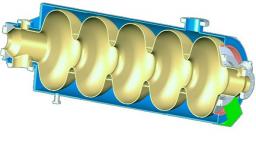New programs (SLHC-PP, EuCARD and the French contribution at CERN) were launched in 2009 to continue development activities focusing on pulsed superconducting accelerators for intense proton beams, carried out as part of Europe's CARE/HIPPI program. These activities have also been spurred by the decisions taken by the SPL (CERN) and ESS-S project managers to adopt 704 MHz superconducting cavities as the reference solution for their proton linacs.
Frequency tuning system
As part of its work in these programs, SACM has developed elliptical superconducting cavities that are optimized for intense beam acceleration in pulsed mode. This operating mode causes amplitude and phase variations in the accelerating field, due to electromagnetic pressure forces that act on cavity walls, which in turn affects the cavity frequency. The higher the field, the more pronounced this phenomenon which can be detrimental to the quality of the accelerated beam. To overcome this problem, SACM has developed a fast frequency tuner and a compensation algorithm. Both were qualified during a test campaign on a cavity with b equal to 0.5 (elliptical five-cell cavity operating at 704 MHz and optimized to accelerate particles with a velocity ratio of b = v/c = 0.5) well suited for study of electromagnetic pressure effects.
Power couplers
Research into this type of accelerator concerns proton beams of several tens of mA and high gradients, in excess of 20 MV/m. Such parameters call for power couplers that are capable of transmitting several hundred kW to each cavity. SACM has developed two prototype power couplers, optimized for a frequency of 704 MHz, and conditioned up to 1.2 MW with a 10% duty factor (which is the limit of our radiofrequency system). After installing one of these couplers in a clean room on the b = 0.5 cavity, the set-up operated at 1 MW at the rated duty factor, in the Cryholab horizontal test cryostat. These excellent results demonstrate that a single coupler is able to supply a high-energy cavity on the SPL or ESS linacs with the required power of approximately 1 MW.
Supratech
SACM has set up a high-performance facility – the only one of its kind in Europe – to condition and test the 704 MHz systems developed for this type of accelerator. The Saclay Supratech facility groups together the equipment required to generate RF power up to a peak of 1.2 MW at 704 MHz, in 2 ms pulses, at a repetition frequency of 50 Hz, together with the test cryostats used to qualify accelerator components under realistic operating conditions.

Mockup of the = 1 cavity developed for the EuCARD program. The cavity is ideally suited for accelerating high-energy proton beams.
Elliptical β = 1 cavities
Drawing on its experience in these systems, SACM has designed a five-cell, b = 1 elliptical cavity, operating at 704 MHz, and optimized to accelerate protons with an energy of around 1 GeV. Its shape is particularly well-suited for operation at a high gradient of 25 MV/m. Researchers are now studying components called “high order mode couplers” used to damp instabilities that are detrimental to the beam. The cavity, made from high-purity niobium (RRR > 300), will be equipped with niobium-titanium, electron-beam-welded flanges, and a titanium helium chamber, also welded. A specially designed titanium side piece, located between the helium chamber and the cavity, is included for fitting the frequency tuner and effectively transmitting the deformations induced by the fast piezoelectric system.
• Accelerator physics and technology › High-Intensity sources and injectors
